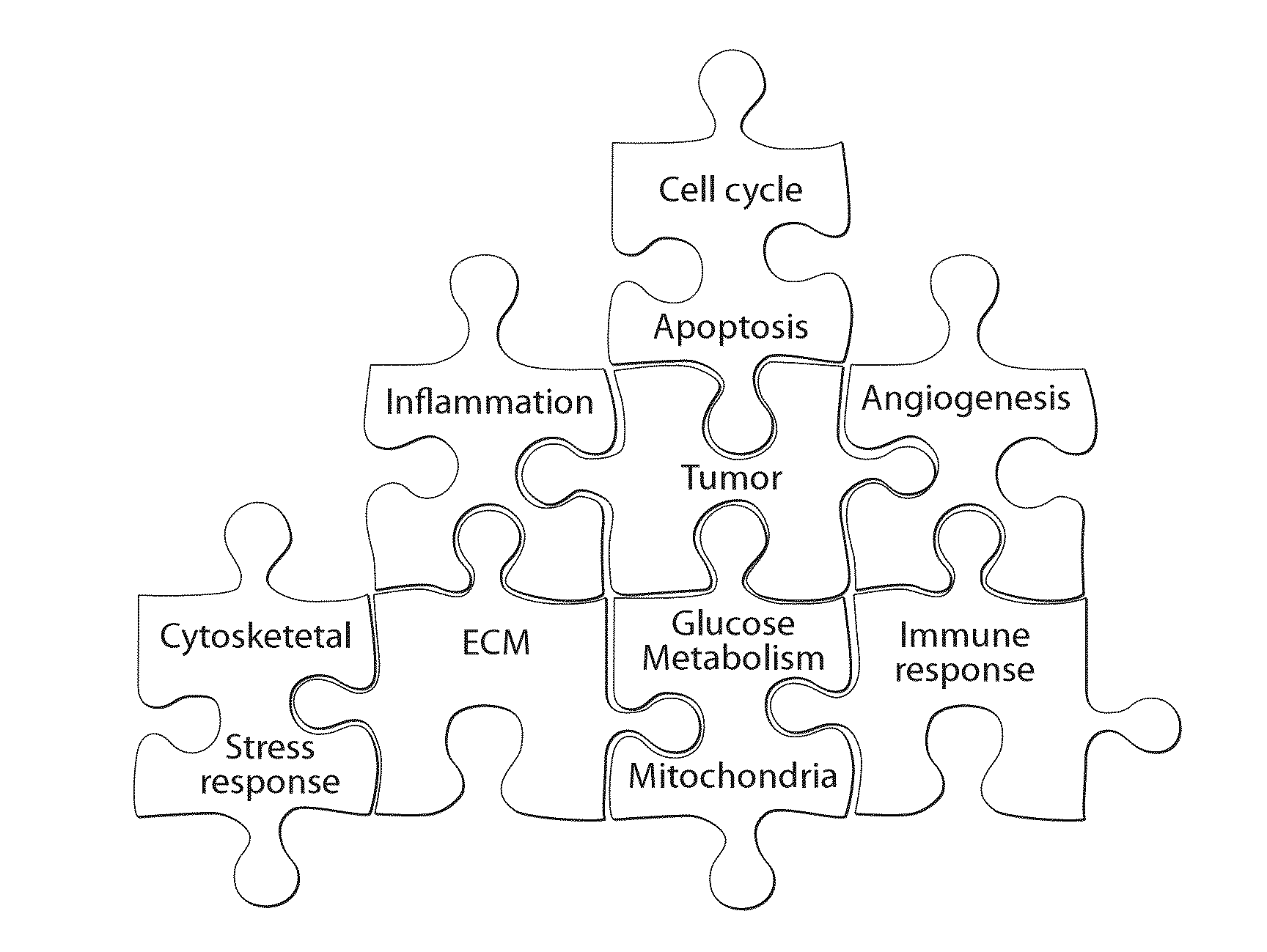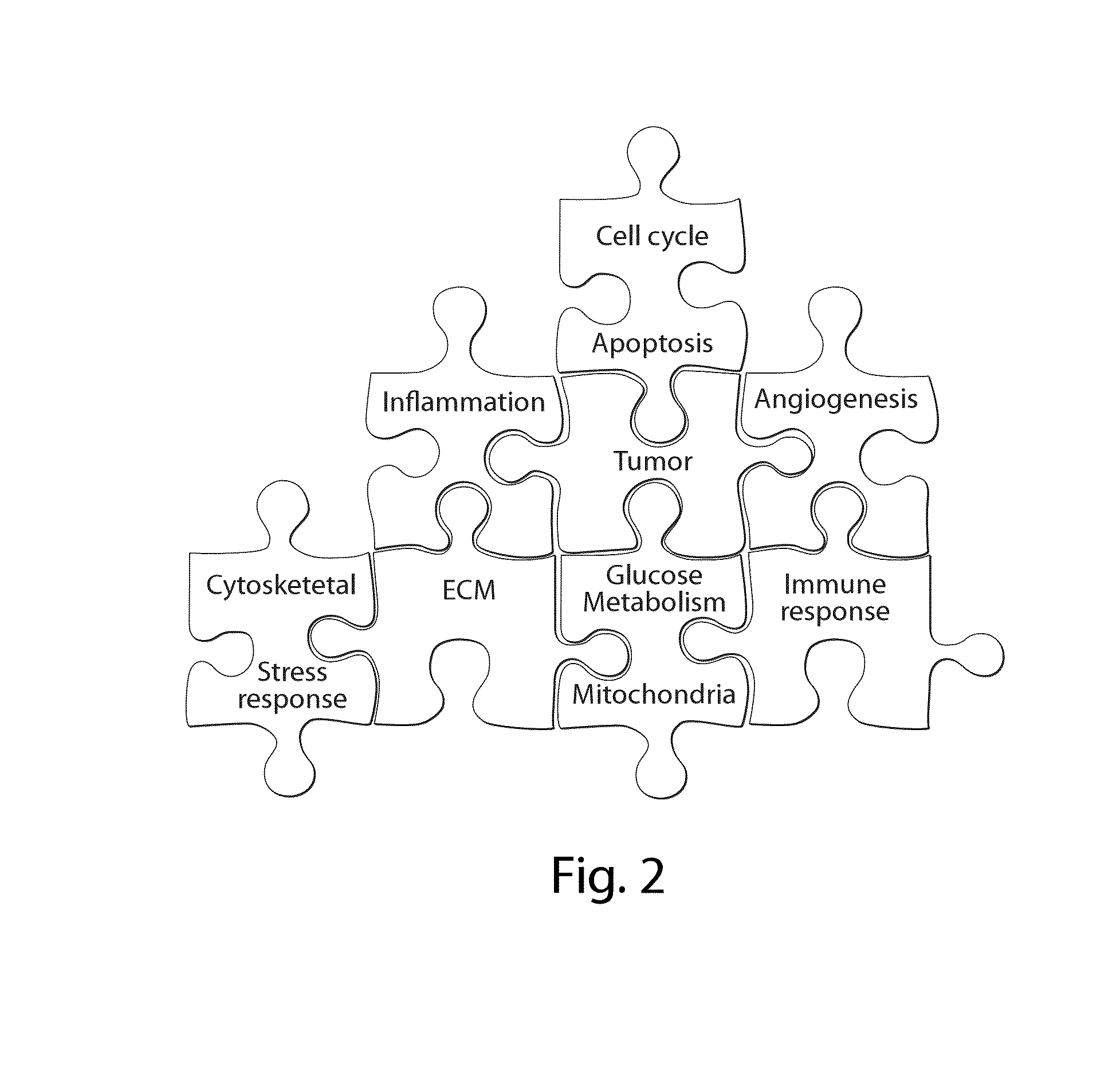Interrogatory cell-based assays and uses thereof
a cell-based assay and cell-based technology, applied in the field of interrogatory cell-based assays, can solve the problems of disease etiology related to cvd and associated co-morbidities such as diabetes and peripheral vascular disease that are yet to be fully elucidated
- Summary
- Abstract
- Description
- Claims
- Application Information
AI Technical Summary
Benefits of technology
Problems solved by technology
Method used
Image
Examples
example 1
Employing Platform Technology to Build a Cancer Consensus and Simulation Networks
[0847]In this example, the platform technology described in detail above was employed to integrate data obtained from a custom built in vitro cancer model, and thereby identify novel proteins / pathways driving the pathogenesis of cancer. Relational maps resulting from this analysis have provided cancer treatment targets, as well as diagnostic / prognostic markers associated with cancer.
[0848]The study design is depicted in FIG. 18. Briefly, two cancer cell lines (PaCa2, HepG2) and one normal cell line (THLE2) were subjected to one of seven conditions simulating an environment experienced by cancer cells in vivo. Specifically, cells were exposed to hyperglycemic condition, hypoxia condition, lactic acid condition, hyperglycemic+hypoxia combination condition, hyperglycemic+lactic acid combination condition, hypoxia+lactic acid combination condition, or hyperglycemic+hypoxia+lactic acid combination condition....
example 2
Employing Platform Technology to Build a Cancer Delta-Delta Network
[0872]In this example, the platform technology described in detail above was employed to integrate data obtained from a custom built in vitro cancer model, and thereby identity novel proteins / pathways driving the pathogenesis of cancer. Relational maps resulting from this analysis have provided cancer treatment targets, as well as diagnostic / prognostic markers associated with cancer.
[0873]Briefly, four cancer lines (PaCa2, HepG2, PC3 and MCF7) and two normal cells lines (THLE2 and HDFa) were subject to various conditions simulating an environment experienced by cancer cells in vivo. Specifically, cells were exposed separately to each of hyperglycemic conditions, hypoxic conditions and treatment with lactic acid. For example, a hyperglycemic condition was created by culturing the cells in media containing 22 mM glucose. A hypoxic condition was induced by placing the cells in a Modular Incubator Chamber (MIC-101, Billu...
example 3
Employing Platform Technology to Build a Diabetes / Obesity / Cardiovascular Disease Delta-Delta Network
[0893]In this example, the platform technology described in detail above in the detailed description was employed to integrate data obtained from a custom built diabetes / obesity / cardiovascular disease (CVD) model, and to identity novel proteins / pathways driving the pathogenesis of diabetes / obesity / CVD. Relational maps resulting from this analysis have provided diabetes / obesity / CVD treatment targets, as well as diagnostic / prognostic markers associated with diabetes / obesity / CVD.
[0894]Five primary human cell lines, namely adipocytes, myotubes, hepatocytes, aortic smooth muscle cells (HASMC), and proximal tubular cells (HK2) were subject to one of five conditions simulating an environment experienced by these disease-relevant cells in vivo. Specifically, each of the five cell lines were exposed separately to each of the following conditions: hyperglycemic conditions, hyperlipidemic condit...
PUM
| Property | Measurement | Unit |
|---|---|---|
| time | aaaaa | aaaaa |
| temperature | aaaaa | aaaaa |
| temperature | aaaaa | aaaaa |
Abstract
Description
Claims
Application Information
 Login to View More
Login to View More - R&D
- Intellectual Property
- Life Sciences
- Materials
- Tech Scout
- Unparalleled Data Quality
- Higher Quality Content
- 60% Fewer Hallucinations
Browse by: Latest US Patents, China's latest patents, Technical Efficacy Thesaurus, Application Domain, Technology Topic, Popular Technical Reports.
© 2025 PatSnap. All rights reserved.Legal|Privacy policy|Modern Slavery Act Transparency Statement|Sitemap|About US| Contact US: help@patsnap.com



